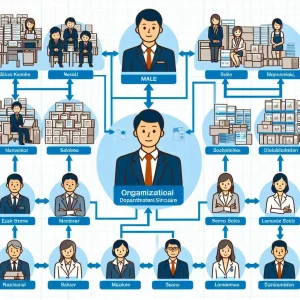The sales and distribution sector plays a crucial role in the success of any business by ensuring that products and services reach customers efficiently. Whether you’re in manufacturing, retail, or any other industry, having a well-structured sales and distribution department is essential for driving growth and maximizing profitability. In this blog post, we will explore the prevailing organizational departmental structure and employee hierarchy in a typical sales and distribution business.
1. Executive Leadership
The foundation of any successful sales and distribution business begins with strong leadership. The executive team sets the strategic direction and ensures that all departments work together seamlessly.
- CEO/President: The top executive responsible for the overall vision, strategy, and performance of the business.
- COO (Chief Operating Officer): Manages day-to-day operations, ensuring that sales and distribution strategies align with business goals.
- CFO (Chief Financial Officer): Oversees financial planning, budgeting, and financial risk management to ensure profitability and financial stability.
2. Sales Department
The sales department is at the heart of revenue generation. It is responsible for identifying prospects, closing deals, and maintaining relationships with customers.
- Chief Sales Officer (CSO): Leads the sales department, setting sales targets and strategies.
- Sales Directors/Regional Sales Managers: Oversee sales operations within specific regions or divisions, ensuring targets are met.
- Account Managers: Manage relationships with key clients, ensuring customer satisfaction and loyalty.
- Sales Representatives: The front-line team responsible for direct sales, engaging with customers, and closing deals.
- Inside Sales Team: Focus on sales through phone, email, and other digital channels, often handling smaller accounts or lead generation.
3. Distribution and Logistics
Once sales are made, the distribution and logistics department ensures that products reach customers efficiently and on time.
- Chief Logistics Officer (CLO): Oversees the entire logistics and distribution process, ensuring that products are delivered efficiently.
- Distribution Managers: Manage the distribution network, including warehouses, transportation, and inventory management.
- Warehouse Managers: Oversee the operations within warehouses, ensuring that products are stored and handled properly.
- Logistics Coordinators: Plan and coordinate the movement of goods from warehouses to customers, optimizing routes and delivery times.
- Inventory Control Specialists: Manage stock levels, ensuring that products are available when needed and minimizing excess inventory.
4. Marketing and Sales Support
The marketing and sales support team plays a vital role in driving demand and providing the tools and resources that the sales team needs to succeed.
- Chief Marketing Officer (CMO): Leads the marketing strategy, focusing on brand development and demand generation.
- Marketing Managers: Develop and execute marketing campaigns that support sales efforts, including digital marketing, content creation, and advertising.
- Sales Support Specialists: Provide administrative support to the sales team, including preparing proposals, contracts, and sales materials.
- CRM Managers: Manage customer relationship management (CRM) systems, ensuring that the sales team has access to accurate customer data and insights.
5. Customer Service and After-Sales Support
Providing excellent customer service and after-sales support is essential for maintaining customer satisfaction and fostering long-term relationships.
- Customer Service Director: Leads the customer service department, ensuring that customer inquiries and issues are handled promptly.
- Customer Service Representatives: The first point of contact for customers, handling inquiries, complaints, and service requests.
- After-Sales Support Managers: Focus on maintaining customer relationships after the sale, including managing warranties, returns, and product training.
- Technical Support Specialists: Provide technical assistance to customers, helping them resolve issues with products or services.
6. Finance and Administration
The finance and administration department ensures that the business operates smoothly and that all financial aspects are managed effectively.
- Finance Director: Manages the financial operations of the business, including budgeting, forecasting, and financial reporting.
- Accountants: Handle bookkeeping, payroll, tax compliance, and financial record-keeping.
- Financial Analysts: Provide insights into financial performance, helping to guide strategic decision-making.
- Administrative Assistants: Support executives and departments with administrative tasks, ensuring that the business runs efficiently.
7. Human Resources (HR)
The human resources department is responsible for recruiting, training, and retaining the talent needed to drive the business forward.
- HR Director: Manages the HR department, overseeing recruitment, employee development, and company culture.
- Recruiters: Handle the hiring process, from job postings to interviewing and onboarding new employees.
- Training and Development Coordinators: Design and implement training programs that enhance employee skills and productivity.
- HR Managers: Manage employee relations, benefits, performance evaluations, and compliance with labor laws.
In a sales and distribution business, having a well-organized departmental structure and clear employee hierarchy is crucial for achieving operational efficiency and driving growth. Each department plays a vital role in ensuring that products and services reach customers successfully, from the initial sale to final delivery and ongoing support. By understanding and implementing this structure, businesses can position themselves for long-term success in a competitive marketplace.
Streamline your organizational structure and employee hierarchy with ZOKO HR, The most intuitive HRM Software for modern businesses.





